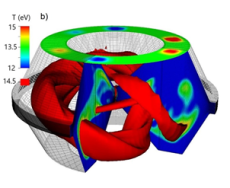Towards Simpler Fusion Power Devices

Simulations were performed to model large 3D perturbations and the role they play on plasma self-organization on the HITSI device at the University of Washington
Science Achievement
The ability to model self-organized magnetically confined plasma systems is an important tool for the goal of predictive modeling of devices for design of fusion power systems. This work has expanded the confidence in the modeling of a complicated plasma configuration that imposes large perturbations with a time-dependent 3-D structure.
Impact
Fusion power technology has the potential to be a baseload electricity generation source with minimal environmental effects, with the two major obstacles being complexity of devices and cost. Self-organized plasma equilibria potentially provide a development path to lower-cost fusion power systems than conventional fusion confinement systems, by reducing the engineering complexity of the device. A key ingredient to developing these devices relies on increased understanding of the dynamics involving large perturbations on a plasma equilibrium.
Research Details
A variety of simulations have been performed to model and assist in understanding the Helicity Injected Torus with Steady Inductive helicity injection (HIT-SI) device at the University of Washington. HIT-SI uses a set of purely inductive magnetic helicity injectors to form and sustain a magnetically-confined plasma equilibrium. The helicity injectors impose complicated 3-D perturbation structures, which oscillate in time, onto the plasma magnetic structure. Plasma self-organization rearranges these structures into desirable equilibria.
Two important parameters for modeling a HIT-SI discharge are the injector oscillation frequency and the spatial configuration of the injectors themselves. Simulations, solving the equations of extended MagnetoHydroDynamics, were performed at NERSC, and validated with experimental results to understand the accuracy of the modeling and provide predictive capabilities for future devices.
Related Links
K.D. Morgan, “Finite-beta simulations of HIT-SI and HIT-SI3 using the NIMROD code”, Ph.D. thesis, University of Washington (2018)
K. D. Morgan, T. R. Jarboe, A. C. Hossack, R. N. Chandra, and C. J. Everson, “Validation of extended magnetohydrodynamic simulations of the HIT-SI3 experiment using the NIMROD code”, Physics of Plasmas, 24, 122510 (2017) DOI: 10.1063/1.4997944
C. Hansen, B. Victor, K. Morgan, T. Jarboe, A. Hossack, G. Marklin, B. Nelson, and D. Sutherland, “Numerical studies and metric development for validation of magnetohydrodynamics models on the HIT-SI experiment”, Physics of Plasmas, 22 (2015) DOI: 10.1063/1.4919277
B. Victor, C. Akcay, C. Hansen, T. Jarboe, B. Nelson, K. Morgan, “Development of validation metrics using biorthogonal decomposition for the comparison of magnetic field measurements”, Plasma Phys. and Controlled Fusion (2015) DOI: 10.108.8/0741-3335/57/4/045010
A. Hossack, T. Jarboe, R. Chandra, K. Morgan, D. Sutherland, J. Penna, C. Everson, and B. Nelson, “Plasma response to sustainment with imposed-dynamo current drive on HIT-SI and HIT-SI3”, Nuc. Fusion 57 (2017) DOI: 10.1088/1741-4326/aa6ec7
T. Jarboe, C. Hansen, A. Hossack, G. Marklin, K. Morgan, B. Nelson, D. Sutherland, and B. Victor, “A proof of principle of imposed dynamo current drive: Demonstration of sufficient confinement”, Fus. Science and Tech. 66 (2014) DOI: 10.13182/FST14-782
D. Sutherland, T. Jarboe, K. Morgan, M. Pfaff, E. Lavine, Y. Kamikawa, M. Hughes, P. Andrist, G. Marklin, B. Nelson, “The dynomak: An advanced spheromak reactor concept with imposed-dynamo current drive and next-generation nuclear power technologies”, Fus. Engr. and Design 89 (2014) DOI: 10.1016/j.fusengdes.2014.03.072
About NERSC and Berkeley Lab
The National Energy Research Scientific Computing Center (NERSC) is a U.S. Department of Energy Office of Science User Facility that serves as the primary high performance computing center for scientific research sponsored by the Office of Science. Located at Lawrence Berkeley National Laboratory, NERSC serves almost 10,000 scientists at national laboratories and universities researching a wide range of problems in climate, fusion energy, materials science, physics, chemistry, computational biology, and other disciplines. Berkeley Lab is a DOE national laboratory located in Berkeley, California. It conducts unclassified scientific research and is managed by the University of California for the U.S. Department of Energy. »Learn more about computing sciences at Berkeley Lab.







